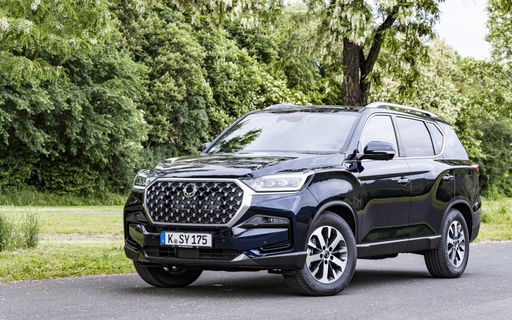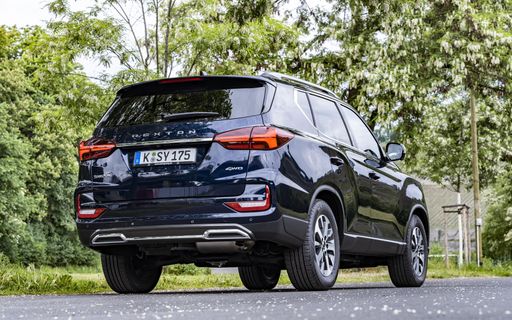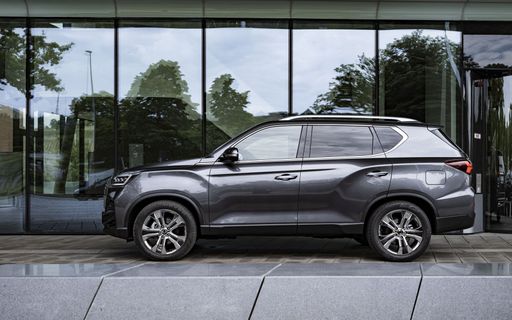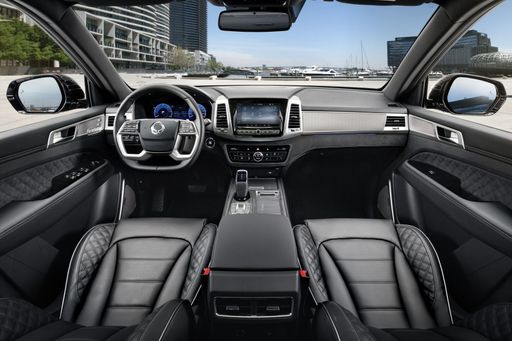Renault Trafic Bus vs SsangYong Rexton – Differences & prices compared
Compare performance, boot space, consumption and price in one view.
Find out now: which car is the better choice for you – Renault Trafic Bus or SsangYong Rexton?
The Renault Trafic Bus (Bus) comes with a Diesel engine and Manuel transmission. In comparison, the SsangYong Rexton (Off-Roader) features a Diesel engine with Automatic transmission.
When it comes to boot capacity, the Renault Trafic Bus offers , while the SsangYong Rexton provides 784 L – depending on how much space you need. If you’re looking for more power, decide whether the 150 HP of the Renault Trafic Bus or the 202 HP of the SsangYong Rexton suits your needs better.
In terms of consumption, the values are 6.80 L per 100 km for the Renault Trafic Bus, and 8.20 L for the SsangYong Rexton.
Price-wise, the Renault Trafic Bus starts at 38200 £, while the SsangYong Rexton is available from 41100 £. Compare all the details and find out which model fits your lifestyle best!
Renault Trafic Bus
The Renault Trafic Bus is a versatile and spacious option for those needing to transport multiple passengers comfortably. With its modern design and practical features, it is well-suited for both business and leisure purposes. Its efficient engine and smooth handling make it a reliable choice for long journeys.
detailsSsangYong Rexton
The SsangYong Rexton stands out in the SUV segment with its robust design and commanding presence on the road. It offers a spacious interior with high-quality materials, providing comfort and practicality for both driver and passengers. The Rexton combines off-road capability with modern technology, making it an attractive option for those seeking a versatile and durable vehicle.
details @ Ssangyong
@ Ssangyong
 @ Ssangyong
@ Ssangyong
 @ Ssangyong
@ Ssangyong
 @ Ssangyong
@ Ssangyong
 @ Ssangyong
@ Ssangyong

|
|
|
|
|
Costs and Consumption |
|
|---|---|
|
Price
38200 - 51100 £
|
Price
41100 - 51300 £
|
|
Consumption L/100km
6.8 - 7.2 L
|
Consumption L/100km
8.20 L
|
|
Consumption kWh/100km
-
|
Consumption kWh/100km
-
|
|
Electric Range
-
|
Electric Range
-
|
|
Battery Capacity
-
|
Battery Capacity
-
|
|
co2
179 - 188 g/km
|
co2
214 - 216 g/km
|
|
Fuel tank capacity
80 L
|
Fuel tank capacity
70 L
|
Dimensions and Body |
|
|---|---|
|
Body Type
Bus
|
Body Type
Off-Roader
|
|
Seats
8 - 9
|
Seats
5 - 7
|
|
Doors
4
|
Doors
5
|
|
Curb weight
2031 - 2321 kg
|
Curb weight
2145 - 2180 kg
|
|
Trunk capacity
-
|
Trunk capacity
236 - 784 L
|
|
Length
5080 - 5480 mm
|
Length
4850 mm
|
|
Width
1956 mm
|
Width
1960 mm
|
|
Height
1973 - 1974 mm
|
Height
1825 mm
|
|
Payload
749 - 982 kg
|
Payload
655 - 770 kg
|
Engine and Performance |
|
|---|---|
|
Engine Type
Diesel
|
Engine Type
Diesel
|
|
Transmission
Manuel
|
Transmission
Automatic
|
|
Transmission Detail
Manual Gearbox
|
Transmission Detail
Automatic Gearbox
|
|
Drive Type
Front-Wheel Drive
|
Drive Type
All-Wheel Drive
|
|
Power HP
110 - 150 HP
|
Power HP
202 HP
|
|
Acceleration 0-100km/h
13.6 - 16.5 s
|
Acceleration 0-100km/h
10.60 s
|
|
Max Speed
161 - 174 km/h
|
Max Speed
184 km/h
|
|
Torque
300 - 350 Nm
|
Torque
441 Nm
|
|
Number of Cylinders
4
|
Number of Cylinders
4
|
|
Power kW
81 - 110 kW
|
Power kW
148 kW
|
|
Engine capacity
1997 cm3
|
Engine capacity
2157 cm3
|
General |
|
|---|---|
|
Model Year
2023 - 2024
|
Model Year
2021 - 2023
|
|
CO2 Efficiency Class
G
|
CO2 Efficiency Class
G
|
|
Brand
Renault
|
Brand
SsangYong
|
Renault Trafic Bus
A Glimpse into the Renault Trafic Bus: An Icon of Versatility and Innovation
Amongst the plethora of vans designed for both business and leisure, the Renault Trafic Bus stands out as an exemplar of functionality, innovation, and style. Let's delve into what makes the Renault Trafic Bus a popular choice in the UK and across Europe, particularly focusing on its technical specifications and state-of-the-art features.
Performance Dynamics: Power Under the Hood
The Renault Trafic Bus, a staple in Renault's fleet, is driven by a robust diesel engine configuration with power outputs ranging from 110 PS to a formidable 170 PS. The diesel engines combine efficiency and power, offering torque figures between 300 to 380 Nm, ensuring smooth power delivery and capable load hauling.
Drivers can choose between manual and automatic transmissions, both designed to complement the Trafic's front-wheel-drive system. This flexibility ensures that drivers experience enhanced driving comfort whether they are navigating urban roads or cruising on the motorway.
Efficiency Meets Economy
The Trafic Bus showcases impressive fuel economy with consumption figures ranging from 6.8 to 7.2 litres per 100 kilometres. This efficiency is crucial for businesses aiming to minimise operational costs and for families seeking budget-friendly travel options.
With a generous fuel tank capacity of 80 litres, the Renault Trafic Bus is built to cover long distances with fewer fuel stops, making it an ideal choice for long haul journeys.
Technological Innovations and Comfort
The Trafic Bus isn't just about robust performance. Renault has integrated a suite of technological innovations designed to enhance driver and passenger comfort. Its cabins are equipped with the latest infotainment systems and safety technologies, providing an optimal blend of comfort and convenience.
The various trims, such as Life, Start, Spaceclass, and their respective EDC variants, cater to different needs and preferences, ensuring that customers can find the perfect configuration for their requirements.
Design and Dimensions: Space for Every Purpose
Space and versatility are at the heart of the Trafic Bus design. With its dimensions ranging from a length of 5080 to 5480 mm, and a width of 1956 mm, this vehicle offers ample room for passengers and cargo alike. The height stands between 1973 and 1974 mm, ensuring that even taller individuals can travel comfortably.
With seating for up to eight people and a payload capacity between 730 to 1010 kg, the Trafic Bus can transform seamlessly between a people-mover and a goods carrier.
Environmental Considerations
Renault has engineered the Trafic Bus with environmental responsibility in mind. The CO2 emissions range from 178 to 190 g/km, which, while modest for its class, aligns with the efficiency and performance goals set for this versatile vehicle. The CO2 efficiency class is rated as 'G', offering transparency in its environmental impact profile.
Conclusion: A Leader in Its Class
The Renault Trafic Bus continues to lead its segment through a blend of power, efficiency, and technological advancements. Whether it's for commercial transport or family adventures, the Trafic offers a reliable and adaptable solution, setting a high standard for multi-purpose vehicles.
For those seeking a distinguished blend of utility and comfort, the Renault Trafic Bus emerges as an exceptional choice, promising performance and innovation on every journey.
SsangYong Rexton
The SsangYong Rexton: Rugged Elegance on Wheels
The SsangYong Rexton is a versatile SUV that combines robust off-road capabilities with luxurious touches, making it a compelling choice for those who demand both adventure and comfort. Let's dive into the technical nuances and innovations that set this vehicle apart in the competitive SUV segment.
Powertrain Excellence
Under the hood, the SsangYong Rexton embodies power and efficiency with its diesel engine. The e-XDI 220 engine delivers an impressive 202 PS, equating to 148 kW, and generates a torque of 441 Nm. This power is distributed through a sophisticated automatic transmission system, ensuring smooth gear changes and an ideal blend of performance and economy. With an all-wheel-drive system, drivers can confidently tackle diverse terrains, making this SUV a capable partner on any journey.
Impressive Fuel Efficiency and Range
Despite its robust performance, the Rexton is mindful of fuel consumption, boasting a fuel economy of 8.2 L/100km. This efficiency is complemented by a sizeable 70-litre fuel tank, providing an extensive driving range, whether you're navigating urban landscapes or venturing off the beaten path.
Design and Practicality
With dimensions of 4850 mm in length, 1960 mm in width, and 1825 mm in height, the Rexton has a commanding presence. Inside, it offers flexible seating arrangements for up to 7 passengers. The boot space, ranging from 236 to 784 litres, ensures you have ample room for all your gear, making it an ideal companion for family trips or outdoor adventures.
Safety and Technology
Safety is paramount in the SsangYong Rexton. The vehicle is equipped with a suite of advanced safety features, although specifics aren't detailed here. Additionally, modern technological integrations in the Rexton enhance the driving experience, making each journey as enjoyable as it is secure.
Cost-Effectiveness
With monthly running costs ranging between €1075 and €1196 and a cost per kilometre of 86 to 95.7 cents, the Rexton offers a balance of power and efficiency without breaking the bank. The vehicle's price range of €47,990 to €59,890 reflects its premium build and the luxuries it affords its owners.
Environmental Considerations
Though the Rexton impresses with its suite of features, it's worth noting its CO2 emissions, classified in the G efficiency class. With emissions between 214 and 216 g/km, potential buyers might consider how the Rexton's performance aligns with their environmental priorities.
Conclusion: A Commanding SUV Choice
The SsangYong Rexton encapsulates the essence of a modern SUV with its blend of rugged capability, luxury, and intelligent design. Whether you're an urban commuter or an off-road enthusiast, the Rexton promises a driving experience that stands out in both style and substance.
Which drive types are available for the Renault Trafic Bus?
Available as Front-Wheel Drive.
The prices and data displayed are estimates based on German list prices and may vary by country. This information is not legally binding.
